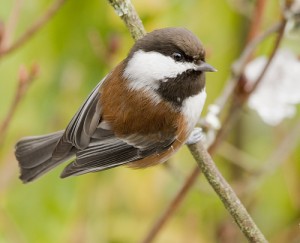The Gargling Chickadees

What do chickadees sound like? Why, everybody knows they say “chick-a-dee-dee-dee,” of course.
These “chick-a-dee-dee-dees” are what many people (and many books) describe as the “calls” — not to be confused with the “songs,” which are usually understood to be the high clear whistled tunes sung by males in a territorial mood:
All chickadee species give “chick-a-dee” calls, but only three of them — Black-capped, Carolina, and Mountain — have whistled songs. Since these three species are the most widespread and familiar North American chickadees, many people tend to judge other chickadees by their standard. “Lacks whistled song,” many field guides say of Mexican, Chestnut-backed, Boreal, and Gray-headed Chickadees. “No song,” say others, or simply “song unknown.”
But the many researchers who have studied chickadee vocalizations for decades might disagree. As far back as 1981, Millicent Ficken pointed out that an often-overlooked chickadee vocalization called the gargle may actually fulfill more of the traditional “song” functions than the whistled songs.
Unlike whistled songs, gargles can be heard from all North American chickadee species. Like traditional songs, gargles are learned; Ficken notes that captive Black-capped Chickadee hatchlings do not develop proper gargles in the absence of an adult tutor. Individual birds typically produce several different types of gargles, forming a repertoire. In most or all species, the gargles are given primarily by males and associated with dominance establishment and territorial defense. They are extremely complex, being made up of many different note types, often with trills and repeated motifs.
For all these reasons, in the species that don’t also whistle, the gargles can be considered “the song”:
Although some field guides may frame them as the outliers, the chickadee species above are not the unusual ones when it comes to the traditional song/call distinction. It’s the whistling chickadees that are unusual, because they have two different kinds of songs — not only whistles, but gargles as well:
The whistling chickadees are a perfect example of how the original “song/call” distinction fails to hold up in many species. Not only can the whistle and the gargle both be called “songs,” but even the “chick-a-dee” calls could be considered songs by some criteria. We should always be suspicious of the many generalizations about birds that we draw from the most common, widespread, and familiar species — remember, they may be the unusual ones.
2 thoughts on “The Gargling Chickadees”
I once had a person tell me that Anna’s Hummingbirds don’t sing because they’re not in the “songbird” group. Much of the baggage from what is or isn’t a song harkens back to the bird song wars of the 18th and 19th centuries when song was defined based on aesthetics, not function. Most Europeans considered American bird song inferior to European birdsong and went to great lengths to demonstrate this “truth”. Whistled songs, especially complex, whistled songs, were usually rated as superior to croaks, gargles and chirps.
Simeon Pease Cheney details this in his book _Wood Notes Wild_ (1891) which includes a facsimile of Barrington’s table of comparative merit. (a scan of Barrington’s table is at: http://www.surfbirds.com/community-blogs/wp-content/blogs.dir/mbalame/archives/comp_merit.jpg ). Cheney politely mocks the notion of European songbird superior, but he also tries to translate bird song into musical notation with mixed results.
Stated as a purely anecdotal, non-quantified observation, I associate the whistle song of Pacific Northwest Black-caps as signally a change in the weather. Other noises, including the gargles are far more common and likely to be associated with reproduction and social interaction.
Fascinating table, Mike. Thanks for bringing it to my attention.
The tendency to define song by aesthetic criteria rather than function remains strong, at least outside the community of professional ornithologists (and perhaps inside it at times). In some ways I’m grateful, because it gives me recurring fodder for the blog!
Comments are closed.